The choice of hood for the kitchen according to the parameters. How to choose a hood in the kitchen? Advice of professional masters
Extract is the most effective smell catcher.
Do I need a hood in the kitchen? The one who uses this technique, will answer: certainly. In fact then it is not necessary to disperse manually a smoke from the burnt food, recollecting grandmother's methods, half a day to sit in an apartment with, soot is much less. Particularly useful device in the kitchens, combined with the living room. But how to choose the right hood in the kitchen?
Advantages and disadvantages of hoods without air duct
Extracts with a duct divert the combustion products through the exhaust pipe to the outside (to the street). Recycling analogues do not require connection to ventilation. In them, air is blown through filters that retain dirt and odors, and then return to the room again.
Benefits
If the duct is connected to a vent window, the air quality in the apartment deteriorates when the appliance is switched off. Therefore, flat and pull-out hoods - an additional tool to improve the quality of the microclimate in the apartment.
Bribes ease of installation, performed with the help of household tools and without special knowledge. Such devices are easy to maintain, changing or cleaning filters. Such hoods are cheaper. This principle of work it is convenient in winter, as it keeps the heat in the room.
disadvantages
Once in 3-6 months, change the carbon filters, which is associated with additional costs. The amount of expenditure depends on the frequency of frying and smoking in the room. It is also believed that they are less effective in cleaning the air of soot and grease than analogues with the duct.
Criterias of choice
 The right choice of hood determines the purity of air in your kitchen.
The right choice of hood determines the purity of air in your kitchen. Engine
This is the working part of the hood. They are open, semi-hermetic and airtight. In the latter case, the resource is increased and noise is reduced.
The impeller is a part of the engine that captures air and takes it out. Some manufacturers use Teflon coating to avoid the accumulation of fats. The use of metal instead of plastic in this part provides more accurate balancing of rotating components, eliminates the effect of "beating" and reduces noise.
Number of motors, turbine
There are single-engine and two-engine models, which affects productivity. Manufacturers offer models with a turbine. But in the latter case, you should not be seduced by the plus in the form of high productivity.
Control
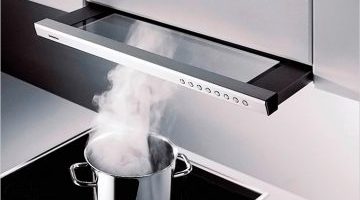 There are types of kitchen hoods with fully automatic control.
There are types of kitchen hoods with fully automatic control. Control is carried out by the sensor, pseudo-sensor, buttons, remote control. The touch option is inconvenient in that it is sensitive to power surges in the network. In the pseudo-sensory version, the micro-slots are protected, unlike the push-button version. As for the remote, this accessory is a matter of taste.
Filters
In all hoods there are fat filters. Filters are replaceable and reusable. An indicator on some hood will indicate that it's time to replace. Permanent filters are washed by hand or in dishwashers.
Performance Controller
Allows you to adjust the volume of pumped air for immediate needs.
overheat protection
The more metal, aluminum alloy parts in the device - the better. The fact is that the cooker hood is affected by high temperatures. In cheap models, these materials are replaced with plastic, painted for metal.
Power
The parameter depends on the size of the kitchen and the love of fried dishes. Define the parameter as follows:
Calculate the volume of the kitchen, multiplying the height, width and length.
The minimum power. The received volume is multiplied by 6 (the coefficient corresponds to 6 changes of air per hour, necessary for cooking on low heat).
The maximum power. The resulting volume of the kitchen is multiplied by 12 (heat in oil is taken into account).
The optimal power is one that exceeds the volume of the room by a factor of 10. So, for a kitchen of 36 m², a hood with a capacity of 360 m2 / h is needed.
It is not recommended to use too powerful models in small areas. This is fraught with the rarefaction of air. If there is no additional supply of air from the street, air from other premises, including the toilet and the bath, compensates for the deficit.
Noise level
The noise level in different models varies from 40 to 70 dB. To imagine how noisy it is, it is enough to know that the bottom figure is a whisper, the upper one is a normal conversation.
The noise level is affected by the design of the ducts. The smaller the bends and cross sections, the quieter the device works.
Additional functions
 Additional illumination of the workplace does not hurt.
Additional illumination of the workplace does not hurt. These "little things" greatly simplify the work of the cook. Modern hoods can be equipped with:
Plate lighting system (conventional incandescent lamps or halogen lamps are used), especially "advanced" lamps are supplemented with brightness adjustment;
The interval switching system activates the hood with a specified frequency at low power, keeping the air in the room clean;
The residual stroke button, which works for another 10 minutes after stopping the device, allows you to finally remove odors;
The residual current sensor turns off the hood if it has worked more than expected;
The sensor of the contaminated filter informs about the maximum contamination, due to which even the forgetful owner will not fail the motor part, there will be no burning of fat;
Ultrasonic air density sensor - determines the air pollution and automatically determines the operating mode;
"Air curtain" with the help of air directs pollution strictly to filters.
Design
Manufacturers offer these types of hoods:
- flat hanging;
- retractable;
- domed;
- desktop.
Rules for selecting the hood:
Flat
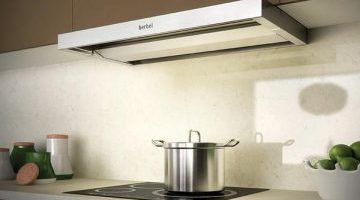 The main advantage of such models is a low price.
The main advantage of such models is a low price. The advantage of such a hood is that it does not depend on the ventilation duct and does not necessitate the need for a duct system. The panel is simply fixed to the wall in the right place.
Classic models absorb only fat, because they are equipped with simple acrylic filters, which are changed after 4 months. But metal filters are also on sale, which are extracted and washed from time to time. They look cumbersome enough. However, the latest models are equipped with two-stage cleaning systems, and the carbon filter (disposable, subject to periodic replacement) eliminates the unpleasant odor.
Built-in retractable
Such models are also called folding, telescopic and sliders. The visible part is a flat panel-shelf, parallel to the hob. As well as flat models of hoods, they do not need special engineering networks. The technique is built into furniture. Thanks to the retractable mechanism, the panel, when the extractor is not used, is pushed to free space. Such devices are suitable for any interior, because only the visible panel remains visible.
The disadvantage is the cost, which is higher than that of suspended flat devices.
Fireplace
These resemble a hemisphere or a trapezoid, part of the chimney to the fireplace. Large size allows the use of powerful fans and filters. These hoods can be recirculated as well as connected to the ventilation shaft. These devices are recommended to install in rooms where the supply of fresh air is not always possible, with plastic windows, and also in a spacious kitchen.
The advantages of this design include high performance, cleaning from dirt and odors, the ability to choose the design that is most suitable for the interior. On sale are models finished with natural wood, glass.
Disadvantages - impressive size and high cost compared to previous models.
Tabletop
Probably, this is the most unusual type of hoods. They are built into the hob. They are installed between the grill and the stove
Island
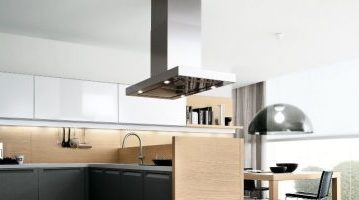 Island hoods are suspended from the ceiling.
Island hoods are suspended from the ceiling. Island hoods are suitable for a large kitchen, where the hobs are located some distance from the wall. They are equipped with additional filtration systems. The peculiarity is that they are dynamic when the panel is allowed to reach the desired height. This is a powerful instrument that corresponds to its purpose.
The shortcomings include noise and price.
Brands
Extracts for the kitchen are presented widely.
Traditionally, buyers trust European quality. These brands are Bosch, Siemens, Kuppersberg, Electrolux. These products are presented at a price of $ 200 (the highest and average price category). The price is justified by the quality of components, assembly. Technics from Poland, Slovenia and South Korea are becoming increasingly popular. They are more budget models.
Built-in extractor - Bosch DHI 665 V 60 IX. Used for conventional kitchen in a block of flats, it is equipped with 2 engines, capacity - 700 m3 / h, noise - 59 dB.
Suspension hood - Hansa OSC 511 WH. Productivity 380 m3 / h, 2 engines, noise - 66 dB.
Fireplace hood - ELIKOR Aquamarine 60 black. The capacity is 650 m3 / h, noise is 56 dB.
Installing the hood in the kitchen is not a whim but a necessity!
Especially in housing, built many years ago and equipped with a single exhaust duct, which no one cares.
A clogged ventilation shaft in combination with sealed plastic windows - the conditions under which the kitchen turns into a stuffy, smoky room.
Therefore, it is important to determine what type of hood is better for the kitchen, which brand and model to choose. Let's do this.
All hoods can be divided into two large classes:
- Flow (outlet, vent).
- Circulating (recirculating).
The flow-through hood is more efficient, it takes the exhaust air out of the house.
The circulation option can be established if the access of oxygen to the kitchen is provided in some other way, and from the extract it is only necessary to clean it from traces of cooking: oil, grease, burnt, soot, smells, etc. This model chases one and the same volume of air.
The supply hood is more difficult to install, it needs a separate ventilation duct, which goes through the wall to the street. Circular should just be properly fixed on the wall. However, the device does not give an ideal result of air purification and requires constant replacement of filters (more often than flow-through filters). In addition, circulators usually work louder than flowing ones.
Distinctive features of kitchen hoods
Inside the hull of any hood is the engine, the twisting blades of the suction fan (or two). The flow entering the hood passes through a filter system (in the exhaust hood, surface filtration is used, since it only protects internal parts of the device from greasy plaque). In centrifugal devices, there are usually two or more filters.
Primary cleaning is carried out by a filter - metal grating. It can simply be washed periodically with hot water. Filters for deep cleaning eliminate the flow of all impurities and odors. It can be coal filters. The grease trap can be paper or synthetic.

Built-in hood in the interior of the kitchen
Most models have a fan speed switch - the more air is more polluted, and the sooner you need to clean it, the more powerful ventilation should work.
After the air is filtered, in circulating models it enters the upper part of the device and blows through the grid back to the apartment. At the flowing device in the upper part of the housing there is an exhaust bushing that connects the unit to the air duct.
Ventilation duct - duct runs through the kitchen to the nearest wall, ends with a grill that opens outwards. A non-return valve is installed at the outlet to ensure that the wind does not generate a return draft.
There are models that combine both modes of operation - they are filtered in a recirculation way, and are able to divert the flow to the street.
Such models are convenient when it is difficult to determine the choice, or when you want to start using the hood, and a large repair with drilling of walls will be carried out later.
What to rely on when choosing?
Do not be guided only by the advice of sellers (interested to praise the most expensive option), or the presence of many options and additional twists.
A competent choice should be based on the conditions in which the device will work: decide immediately where it will hang, calculate the volume of the kitchen, measure the surface of the plate. Armed with all these data, go to the next paragraphs.
Types and varieties
What are the hoods for the kitchen? Flow models can be:
- with upper outlet;
- with rear outlet.
That is, they differ in the location of the outlet. The location at the top of the case is common and most popular. It allows you to conveniently connect the body of the device with air ducts of any shape and size.
The rear outlet is convenient to use if the hood is hanging directly on the wall where the outlet is made - it can be placed directly behind the hood. The interior of the kitchen, in this case, does not suffer from a heap of ventilation pipes.
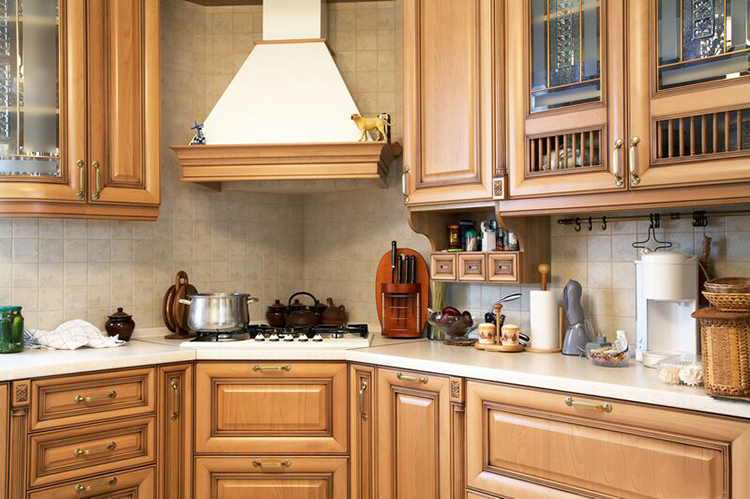
Corner hood
On the location of the hood are:
- The wall.
- Island.
- Corner.
- Built-in.
The most common are wall models. They can differ in form and function. But they are united by a flat back wall and placing above a plate, attached to the wall.
If the plate is located in a corner, it is clear that it will be most convenient to use a special corner construction of the hood.
The islands do not have any flat side. They are used if the stove is stand alone (this happens in restaurants and large kitchens of non-standard layout).
Embedded are placed inside any locker in the kitchen.
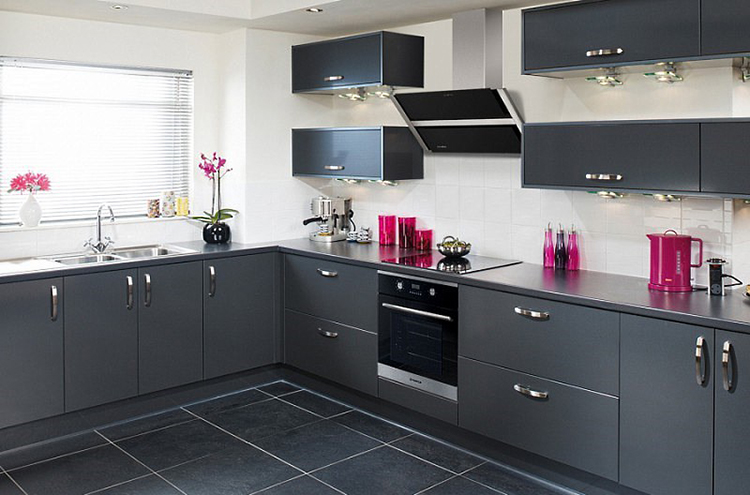
Inclined drawing model
The appearance of the buildings may also be different. They may be:
- In the form of a dome (bulky, but a large umbrella provides an effective capture of vapors over the stove).
- Flat (modern, often with a glossy panel and electronic control).
- Inclined. They have a glossy flat panel that is further away from the wall in the upper part, and near the bottom.
Performance
The power of the suction fans is of great importance and is selected according to the dimensions of the room.
Performance is characterized by the volume of air that the unit is able to pass through itself in 1 hour.
Sanitary standards state that in the kitchen, a complete air renewal should be made 6 to 12 times per hour.
Thus, the resulting indicator of the volume must be multiplied by 6, 7, 8 ... or 12. What figure to choose - decide for yourself. Weigh how intensively you use the kitchen, how many times a day? Do you have a "smoke pillar"? How hot is the room now, before installing the hood? Answering to yourself these questions, you can decide how much powerful equipment you need.
 The bathroom is the wettest place in the apartment. will help maintain the humidity in the room at a normal level.
The bathroom is the wettest place in the apartment. will help maintain the humidity in the room at a normal level.
How to choose the right hood in the kitchen without a duct? Read the tips.
The exhaust in the garage is necessary to remove fumes of gasoline and harmful emissions. This topic is useful for those who plan to organize an extract in the garage with their own hands.
Optimal noise level
The more powerful the device, the more noise it makes. In addition, the circulation hoods usually hoot more strongly.
 In the documents you need to see what level of noise the device creates:
In the documents you need to see what level of noise the device creates:
- 34 - 45 dB is a sound a little louder than a whisper. Usually dishwashers work at the same level.
- 45 - 54 dB is the permissible level.
- 54 - 65 dB - the level of a person's voice in a normal conversation. Quite noisy for household appliances!
Recordsmen for quiet operation - instruments up to 36 dB, have a motor in soundproof material, with gaskets between the main body.
Dimensions
The lower surface area of the hood must match the dimensions of the slab. A little more - you can, but less - no! In such an instrument, there will be no sense, because the vapors and smells will evaporate past him.
If you want a compact model, it is advisable to pay attention to flat models with a sliding panel.
Control
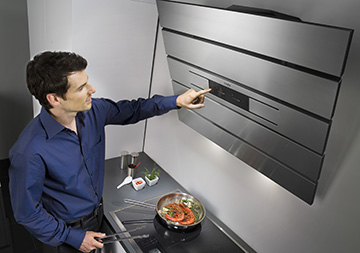 Management can be:
Management can be:
- slider or slider;
- button;
- touch.
Of course, the way management affects the appearance, convenience and price.
Do not always need to take the most expensive option - is it really convenient?
Touch panels are complex electronics inside, which means that it can fail the first and can not be repaired properly. It is especially necessary to be cautious if there are jumps and voltage interruptions in the power grid.
Sliders and sliders are inexpensive, but if they are located on the lower plane of the device, they will quickly become covered with a coating of grease and dirt. And washing them is difficult.
Manufacturers overview
Which firm hoods are better for the kitchen? Many companies are not engaged in manufacturing, but in the assembly of hoods. Others only realize finished products. If we talk about manufacturers, we choose between devices from:

- Cata (Spanish);
- JetAir (Italian);
- Faber;
- Elikor;
- Falmec;
- Bosch;
- Ariston;
- Electrolux;
- Candy;
- Siemens.
Hoods from Bosch, high-tech and high-quality, but are at times more expensive than their counterparts. For example, another German firm Siemens offers its equipment cheaper, about a third.
Among the models of Kandy, you can choose the device at the price of the middle class. He is likely to be different in simple design and management, but will not give in to quality.
Instead of confinement: what kind of hood for the kitchen is better?
What kind of hood is better to buy in the kitchen? Briefly we will take a cut of all the important points, which, when buying, are advised to pay attention.
So, a good hood, this:
- Flow (or ventilation).
- Suitable for kitchen and stove sizes.
- Its body is made of food, non-oxidizing steel or satin aluminum.
- It necessarily has several power modes (according to the owners' reviews, it is very inconvenient to use a hood in which there is only one mode).
- It does not irritate with its hum: 40 dB or less.
- For lighting it uses neon lamps.
- Control of her button or touch.
- Perhaps there is a retractable panel.
- The fat-absorbing filter of good extraction has several layers (excellent, if 5!).
- It can be of any shape, depending on the location and taste of the hostess.
- It fits into the interior, and is not striking.
Useful additional functions: timer, programming and residual running. The latter makes the work more economical, because the technique after maximum mode goes to 5 - 10 minutes of quiet. Many are comfortable to use the remote control.
Video on the topic
Kitchen - a room that needs more quality ventilation than others. And it's not even the smells that arise during cooking. In the kitchen air, particles of steam, grease and soot are almost always present. They settle on the ceiling and walls, forming a sticky, yellowish coating, but the most unpleasant thing is that these particles are inhaled by all the inhabitants of the house, and this in no way improves health. Air conditioners do not provide the necessary air circulation, so in order to avoid all these problems, in the kitchen it is necessary to install the hood. On how to choose the right hood for the kitchen, we'll talk in this article.
The first parameter, which is worth paying attention to when choosing a cooker hood, is its power. The more powerful the device, the better it will cope with its functions. But powerful hoods have a higher cost, so it is more reasonable to use the "necessary and sufficient" rule when buying.
It is not difficult to determine the required output power for a particular kitchen. First of all you need to know the volume of the kitchen. To do this, it is enough to multiply the kitchen area by the height of the ceiling. The minimum hood must pass through itself an air volume equal to 10 volumes of kitchen per hour. Thus, for a kitchen with an area of 8.5 square meters and a ceiling height of 2.8, a hood with a minimum capacity of 8.5x2.8x10 = 238 cube / hour is needed.
However, there are a number of other factors that need to be considered when determining the minimum required output power:
- If a carbon filter is installed in the cooker hood (we'll talk about the types of filters later), then 10% should be added to the received power;
- If the kitchen is combined with a living room or a dining room, the power of the hood is increased by another 30%;
- And, finally, working "at the limit", the hood will quickly fail, so that a power reserve of 30-40% will not be superfluous.
Thus, the minimum output of an extract with a coal filter for a kitchen area of 8.5 m2 is approximately 477 cube / h. The average capacity of kitchen hoods ranges from 500 to 700 cubic meters per hour, so that almost any of them is suitable for work in a small and medium kitchen.
Type of filter
The second most important parameter of kitchen hoods is the type of filtration used in them.
For flow hoods, a single grease filter is sufficient, while for a circulation filter a double filtration system is necessary - a carbon filter is added that neutralizes unpleasant odors. Let's consider each type of filters in more detail.
Greasable

Grease filter
These filters are a cassette with an insert of a filter material - sintepona or nonwoven. When the filter layer becomes dirty, the cassette is discarded and a new one is inserted instead.
There are also reusable aluminum filters that need to be cleaned periodically.
Carbonic
These filters are also called fine filters. Filtration in them is carried out through the passage of air through the layer of activated carbon powder, which perfectly absorbs excess moisture, unpleasant smells and even tobacco smoke. The thicker the layer of coal powder, the better filtration will occur. True, such filters require a larger power reserve. The service life of the fine filter is from 6 to 12 months.

Coal filter
If you get a flow-through hood, you can do with a single-filter model, but if you have a circulation hood, then you can not do without a fine carbon filter.
There are budgetary models of hoods, in which there are no filters at all. But to buy such is not recommended, as the particles of grease and soot will in this case settle on the fan blades, which can lead to breakage.
Extraction Size
The size of the hood is a parameter that does not affect its functionality. However, it can become decisive, especially when it comes to small kitchens. The width of the hood can not be less than the width of the cooker. Otherwise, the hood will not completely catch the polluted air. In addition, it is necessary to take into account the minimum allowable distance from the hob to the hood. It should be no less than 65 centimeters for electric stoves and 75 centimeters for gas stoves. Thus, to install in the kitchen with low ceilings high dome hood will not work.
Hood Construction
The size of the hood depends on its design. There are five types of designs: built-in, dome, island, pull-out and classic.
Classical
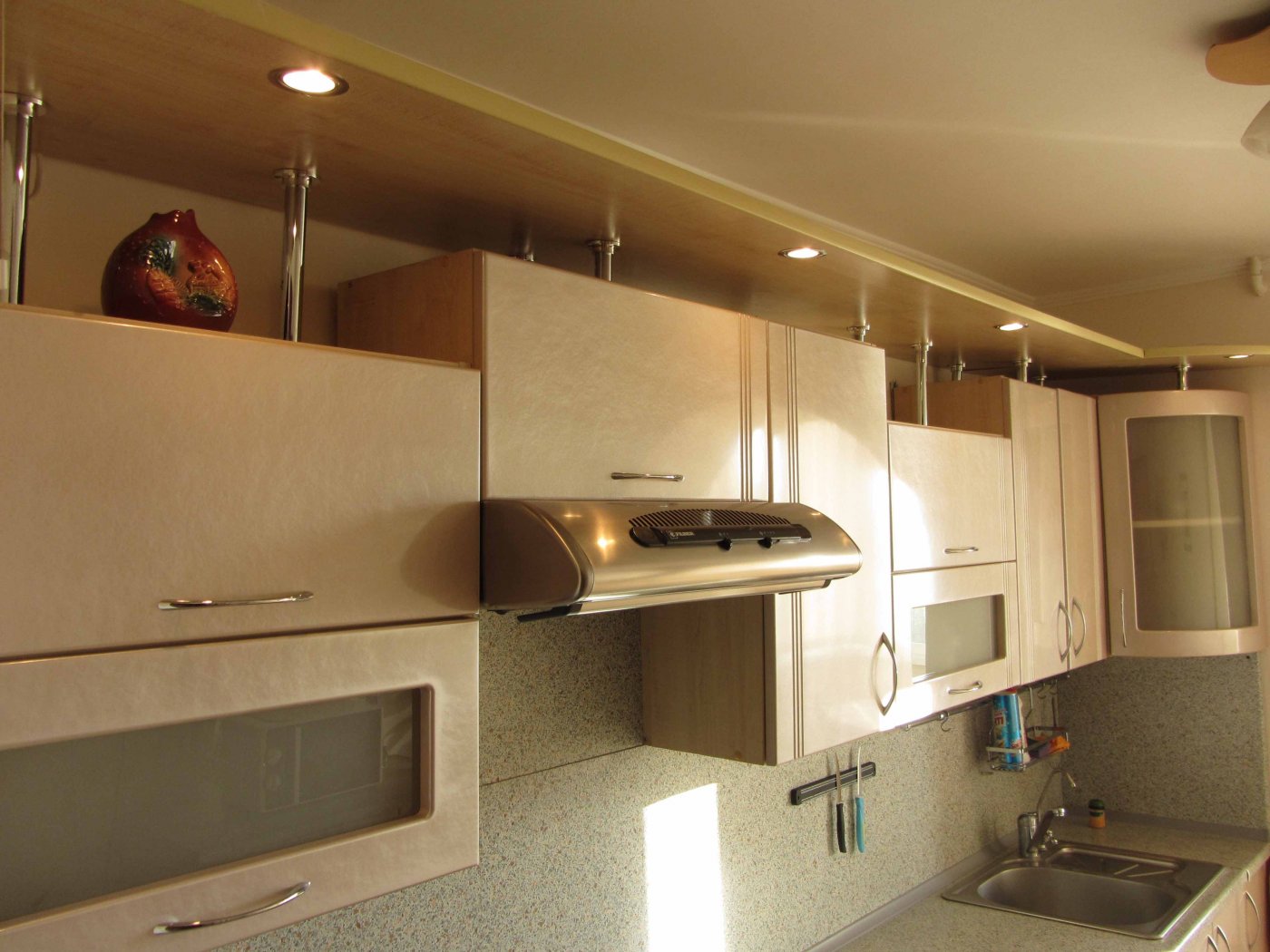
Classical circulation hood
The most simple and inexpensive hoods. Classic retractors work in a circulating mode and are characterized by a simple mounting method. You can install such an extract in any kitchen.
Dome hood
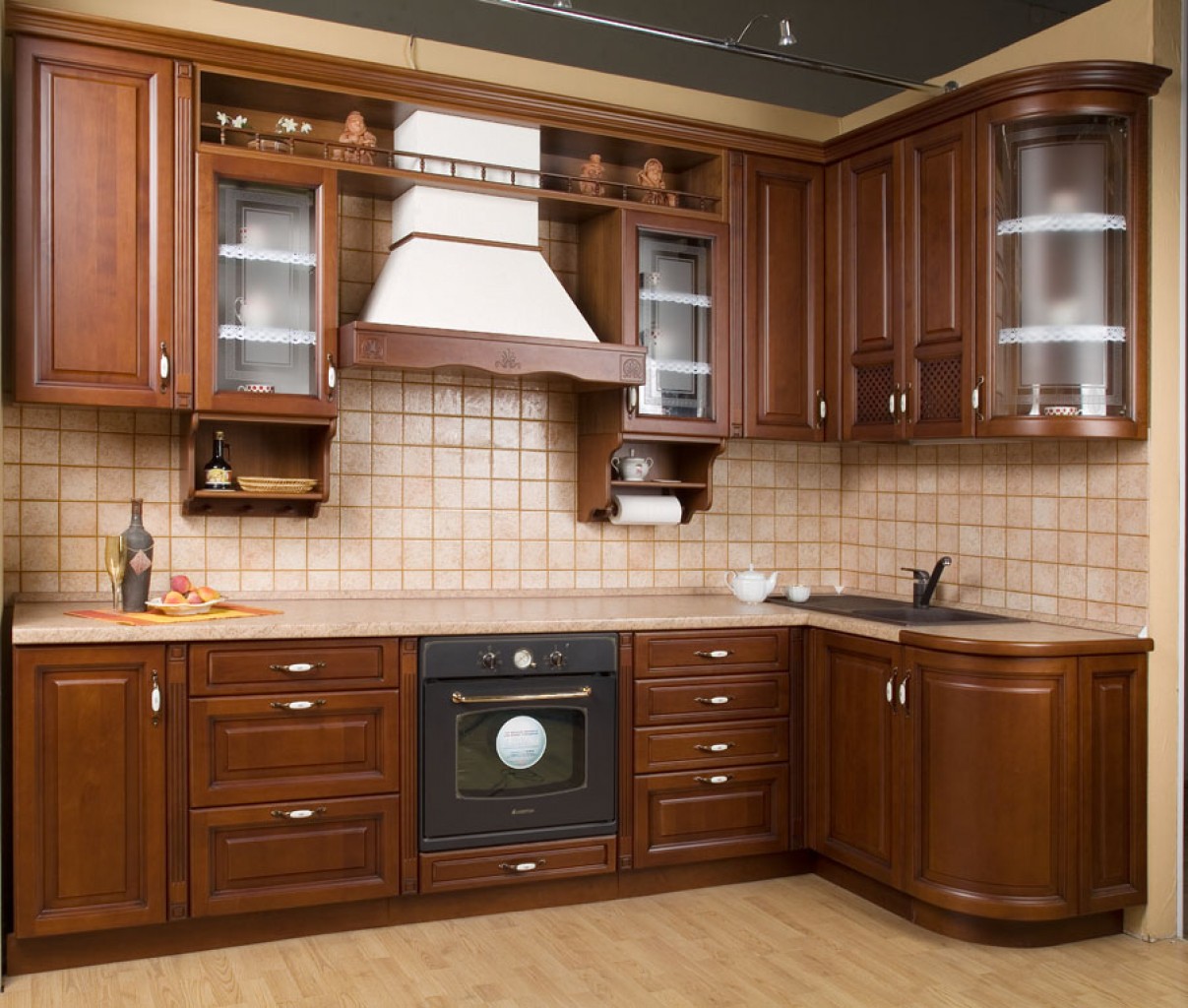
Dome hood
These hoods in their shape resemble a dome and can work both in circulation and in flow mode. In terms of dimensions, this is the largest type of hoods, but the efficiency of their operation is much higher than that of other models. Installation of such an extract is carried out only in those places where it is possible to connect them with ventilation.
Retractable

The exhaust panel in the off state can be hidden (pushed into) the housing, which saves space. This type of hoods is relevant for small kitchens, though, as a rule, they have low power.
Built-in
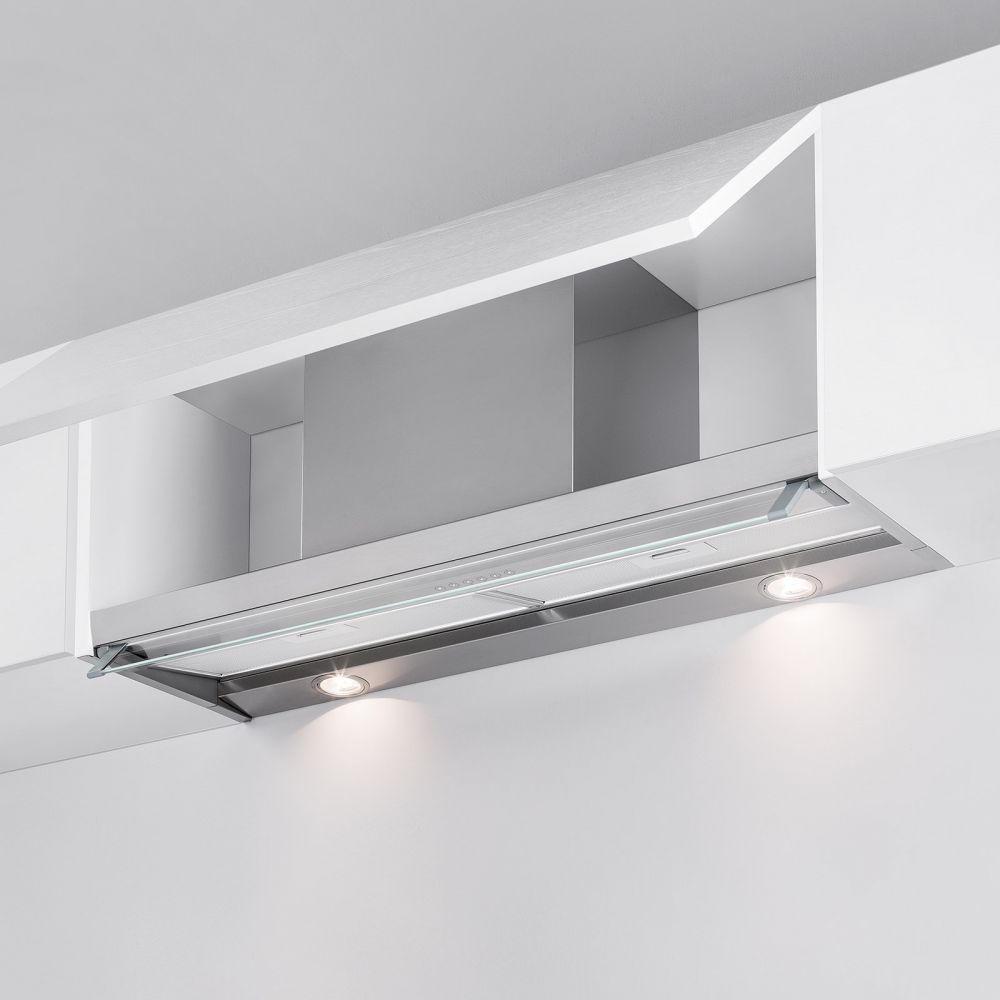
The main feature of these models is that they do not have an external casing, but are designed for embedding in kitchen furniture. The cabinet for extracting will have to be ordered specially, but it will be hidden, thus not violating the design of the kitchen.
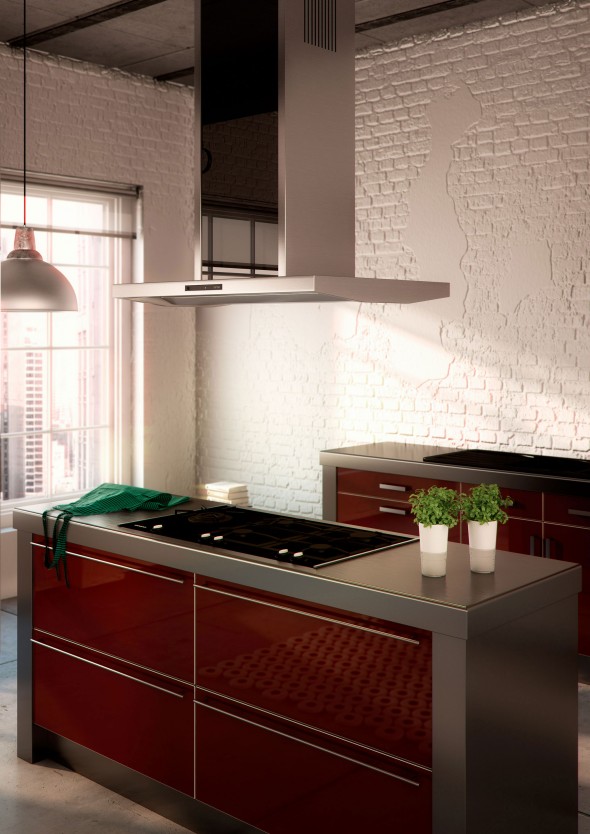
By their design, island hoods resemble domes, for the only difference is that they are not attached to the wall, but only to the ceiling. Recommended for use in large kitchens, the cooker on which is located in the middle of the room.
Air duct
The presence of an air duct (connection with ventilation) at the hood significantly improves its productivity, although it increases the overall dimensions. When installing the duct, it should be noted that each bend (bend) reduces the performance of the hood by 5%, thus requiring a proportional increase in power. Thus, if you purchase a hood with ductwork, we recommend that you first determine its design in order to correct the minimum required power of the device.
Keep in mind that smooth ductwork contributes to better airflow, and corrugated sleeves, despite the convenience of their mounting, are hampered.
Type of lighting
Practically all modern hoods are equipped with lighting. The cost of the hood may vary, albeit not significantly, from the type of lamps that are used in the lighting system. Halogen lamps are more expensive than others, but consume a minimum of electricity and create the most natural light. Normal incandescent lamps are the cheapest, but quickly burn out and are the most "uneconomical". The fluorescent light serves for a long time, but this light distorts the natural colors of the dishes, which can adversely affect the culinary process (for example, when visually determining the degree of roasting).
Noise level
The noise level produced by the hood is directly proportional to its power. That is, the more powerful the fan motor, the more noise it produces. On the other hand, a powerful fan for cleaning the air in the room needs to work "at maximum" for a much shorter period of time. So it's up to you to decide whether you want to hear a "noisy exhaust" for a short time or "enjoy" the quiet buzz of a low-power motor all day.
Body material and appearance
The appearance of the hood, as well as the material from which it is made, are free to choose according to their preference. Someone prefers a hood from the stainless steel in the style of hi-tech, someone - a dome hood stylized as an antique stove, and someone will prefer a low-key plastic models. The main thing is that the material from which the hood is made is of high quality and durable.
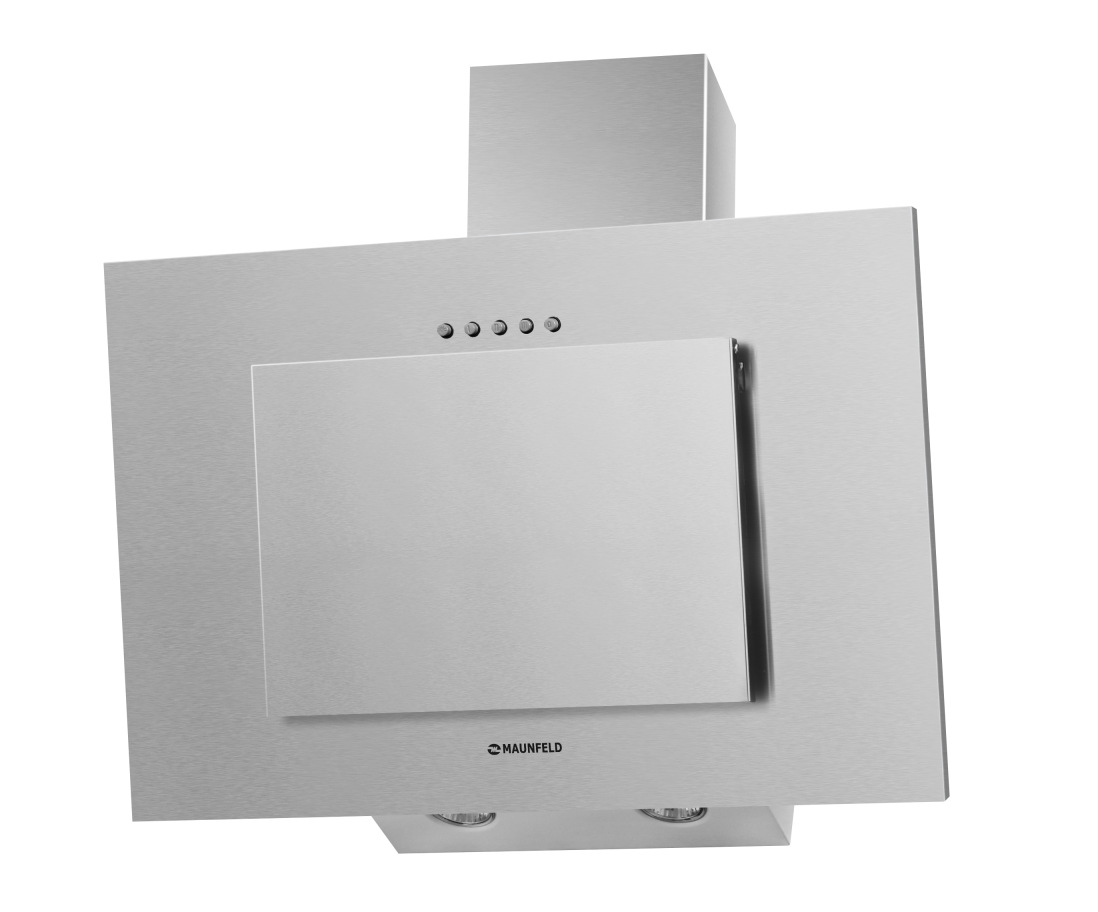
Extractor made of 'stainless steel'
Please note that stainless steel hoods require significantly more complex care than plastic or laminated models. On metal even small drops of water after drying are much better visible.
Control Panel
There are three types of control panels for kitchen hoods.
Button control
The simplest version of the panel, in which each function of the hood corresponds to a separate button. The disadvantage is that to change the power it is necessary to press the button several times.
Slider or slider control
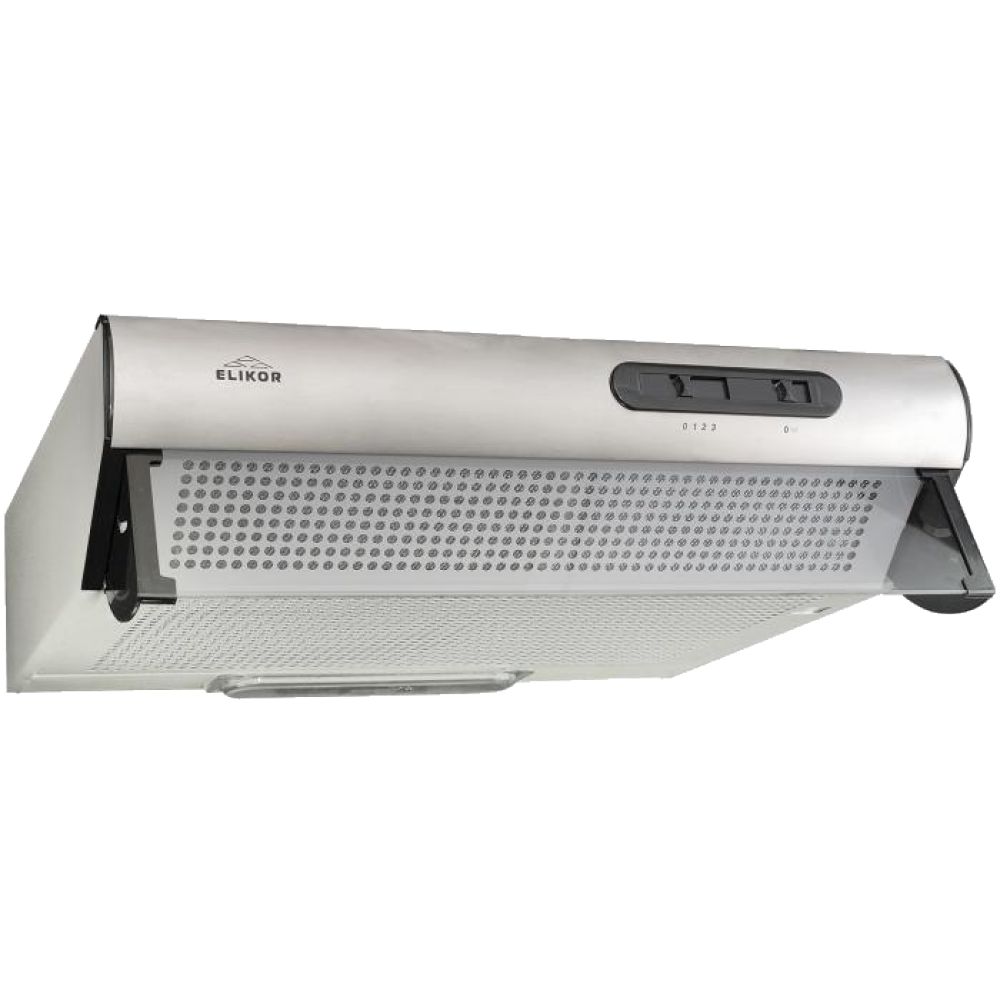
Switching functions is carried out by moving the handle of the slider along the corresponding indexes. A reliable type of adjustment, allowing you to adjust the power as accurately as possible.
Touch Control
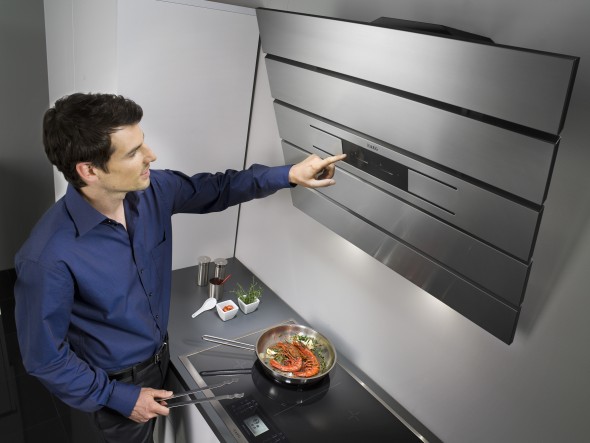
Sensor control of the hood
The most "elite" type of panel, in which switching is made by an easy touch to the sensor.
Additional functions
Other things being equal, the deciding factor in choosing the hood may be the presence of additional functions in them. Here are the main ones:
- Timer. The function allows you to set the on / off time of the hood;
- Humidity and smoke sensor. Automatically turns on the hood if necessary;
- Periodic inclusion. Unlike the timer, which allows you to simply turn on or turn off the hood at a certain time, the periodic start function allows you to set a constant mode of operation. For example, include the hood every hour for 15 minutes;
- The remaining stroke of the fan. After turning off the hood, the function continues the fan at low speed for 10-15 minutes. Due to this, the maximum ventilation of the room is achieved.
Select by manufacturer
The most popular are the hoods of such proven brands as Siemens, Bosch, Electrolux, Kuppersberg and Zanussi. Most of the models of these hoods belong to the middle and higher price segment, but the quality and reliability of the devices justify their high cost.
Among the relatively inexpensive but at the same time high-quality extracts can be noted Slovenian Gorenje, Polish Hansa, Russian ELIKOR and South Korean Samsung.
We do not recommend buying hoods of unknown Chinese and Taiwanese manufacturers, even despite their low cost.
In conclusion, we suggest you watch the video from Channel One on how to choose a hood for the kitchen.
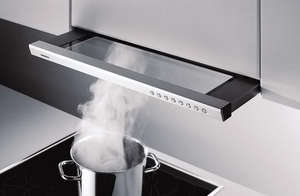
Modern kitchen has long ceased to be perceived as a room where food is simply prepared. Now they gather here with the whole family, have breakfast, have supper, talk or just relax. Therefore, the smell of burned onions or burned fish, potatoes will not like anyone. To do this, there is a special device - a hood, which does not allow to spoil the home warm atmosphere. However, you need to know how to choose the hood in the kitchen correctly.
 Depending on the method of air purification, the hoods for the kitchen are of two types. In the first case it is a question of tap-off hoods. They take the working air out of the room and take it out with special channels to the outside. In the second case, recirculation and purification exhausts are meant. These include those models that themselves, using filters, purify the exhaust air. They are not connected to the ventilation system.
Depending on the method of air purification, the hoods for the kitchen are of two types. In the first case it is a question of tap-off hoods. They take the working air out of the room and take it out with special channels to the outside. In the second case, recirculation and purification exhausts are meant. These include those models that themselves, using filters, purify the exhaust air. They are not connected to the ventilation system.
Such devices are equipped not only with a conventional metal filter, but also have a carbon cleaning element that removes not only the soot and grease from the incoming air, but also eliminates odors. However, quite often you can see models with air vent or combined.
You need to know how to choose the hood for the kitchen correctly. Different designs will not only have their advantages, but also drawbacks.
The most popular models are exhaust hoods. They attract the buyer with a moderate price and high efficiency. Nevertheless, these devices will require additional effort and cost during the installation, since the air it takes from the room must be taken out. To divert the air flow you will need to separately purchase a corrugated aluminum air duct, which will be connected to the kitchen ventilation system.
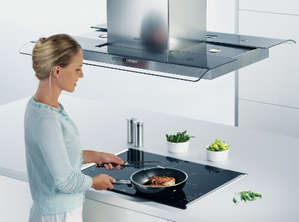 The next few proposals can not fail to pay attention to the fact that it is impossible to choose a hood for the kitchen, if there are no specific knowledge for this procedure. Among the drawbacks of the divergent models there is always the risk of power loss, when the fans will drive the selected airflow through the duct, which constantly stumbles and undergoes pressure drops. Do not forget about the aesthetic side of the issue, because you do not just need to know how to choose a kitchen hood, but also be sure that the corrugation for tapping the air under the ceiling will not spoil the kitchen interior.
The next few proposals can not fail to pay attention to the fact that it is impossible to choose a hood for the kitchen, if there are no specific knowledge for this procedure. Among the drawbacks of the divergent models there is always the risk of power loss, when the fans will drive the selected airflow through the duct, which constantly stumbles and undergoes pressure drops. Do not forget about the aesthetic side of the issue, because you do not just need to know how to choose a kitchen hood, but also be sure that the corrugation for tapping the air under the ceiling will not spoil the kitchen interior.
Again, the question " Which type of hood should I choose for the kitchen? ". Continuing the conversation about the models of purification, it should be noted that their effectiveness is not so high in comparison with the extraction structures.
The filters used are not durable, they need appropriate care and replacement several times a year.
Structurally, the purification models are much more complicated, which makes their cost also high enough. Such autonomous systems are more suitable in cases where there is no possibility to connect to ventilation ducts.
Do not forget about compatibility
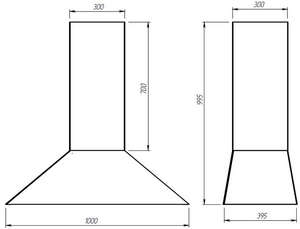 Answering the question " How to choose a hood for the kitchen?", It is necessary to note the fact that the models can be equal in width to 50, 60 and 90 centimeters. The figures presented correspond completely to the width of the kitchen stoves.
Answering the question " How to choose a hood for the kitchen?", It is necessary to note the fact that the models can be equal in width to 50, 60 and 90 centimeters. The figures presented correspond completely to the width of the kitchen stoves.
Do not allow this appliance to be smaller or wider than your gas stove. Among housewives, there is an opinion that the models must necessarily be wider than the slab in width. In this case, the air will be carefully removed from the prepared dishes, and the kitchen is almost not saturated with a variety of smells.
At the moment when we choose a hood for the kitchen, it is necessary to take into account the next nuance. You can buy:
- suspended;
- embedded;
- dome or fireplace.
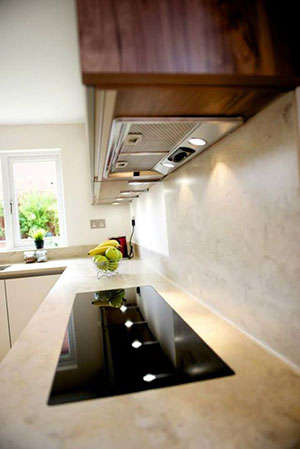 The first are fastened directly above the working cloth of the plate, because of what is quite noticeably stand out against the background of the furniture present. Some models need a sleeve to drain hot air, while others do not. In the second case, the hood can be installed directly into the furniture itself. In this case, the exhaust pipe will be reliably hidden from prying eyes. In the latter version, models are used which hang over the plate itself and are similar to the fireplace chimney.
The first are fastened directly above the working cloth of the plate, because of what is quite noticeably stand out against the background of the furniture present. Some models need a sleeve to drain hot air, while others do not. In the second case, the hood can be installed directly into the furniture itself. In this case, the exhaust pipe will be reliably hidden from prying eyes. In the latter version, models are used which hang over the plate itself and are similar to the fireplace chimney.
Therefore, before you buy such a hood for the kitchen, you must be able to choose the right type and model. Many of these modern appliances, in terms of design, are perfectly capable of decorating any room where food is prepared.
It should be remembered that the built-in and hanging extracts belong to the purification models, and the dome ones to the tap-off type.
That's why, in the latter case, you need a line to drain hot air.
We calculate the power correctly
In our time, you need to be able to choose the right hood by type and power. To be exactly sure which one to bring into the house, 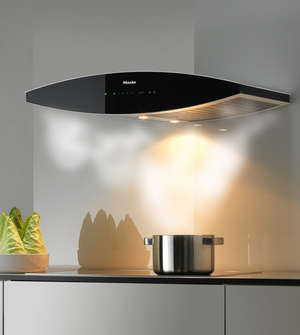 and that it came up for the kitchen, you need to do a little mathematical calculations.
and that it came up for the kitchen, you need to do a little mathematical calculations.
Proceeding from the fact that this household appliance does not have many technical parameters, it is not necessary to read the streams of special documentation. In order to determine the power selection for the kitchen, it is necessary to pay attention to these parameters. They indicate how much the specific model can pass through itself, namely in cubic meters and per unit time (hour). And, answering the question " What is the power to choose for the kitchen hood, so that the purchase was done correctly?", We will carry out simple calculations. In the kitchen, ideally all the air should be filtered for an hour. To do this, the room volume must be multiplied by 10.
Nevertheless, you will not be able to select exactly such a model as you need. After all, a certain space is occupied by kitchen furniture. Take care of some certain power reserve, which will compensate for the loss of air in this room. Such a step, as a reserve of power, will allow the machine to serve a longer period, and also will allow to work with less noise.
Ideally, it is right for the kitchen to choose the hood such that in case of burning, and, also considering that it stays at a height of 70 to 80 cm, it was able to rapidly evacuate and filter the smoked air.
Only then can we say that her work is effective.
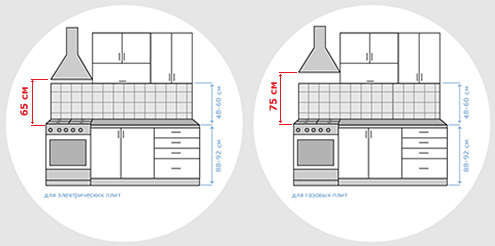 In order to pick up this household appliance, you do not need to look for special videos and see what kind of hood there was filmed, and how it is fastened. Everything is much simpler. It is necessary to increase the area of the room, which, for example, is 10 sq. M., Multiplied by the height of the ceiling, let it be 2.5 meters. Get 25 meters of cubic. Of these, we subtract the space occupied by the furniture. Let's say 4 meters. We get the working volume of 21 m. In this case it will be enough to have models with a capacity of 250 or 280 cubic meters per hour.
In order to pick up this household appliance, you do not need to look for special videos and see what kind of hood there was filmed, and how it is fastened. Everything is much simpler. It is necessary to increase the area of the room, which, for example, is 10 sq. M., Multiplied by the height of the ceiling, let it be 2.5 meters. Get 25 meters of cubic. Of these, we subtract the space occupied by the furniture. Let's say 4 meters. We get the working volume of 21 m. In this case it will be enough to have models with a capacity of 250 or 280 cubic meters per hour.
On many videos you can see the models are almost identical in size, but installed in the kitchens of different squares. This indicates that the standard capacity is between 200 and 1000 cubic meters. m / h, which is achieved by the power of the installed fans and their number.
It should be noted that the hoods are single-engine and twin-engine. The latter are much more productive.
Dinner is being prepared! I ask for silence!
It is very important for the kitchen to choose a low-noise hood. However, even work at a reduced speed will not be enough to reduce noise.
Buying this household appliance, be guided by the indicator of its noise, which can be a minimum of 40 to 50 dB (you can listen to the recommendations of experts on video).
Work on bugs
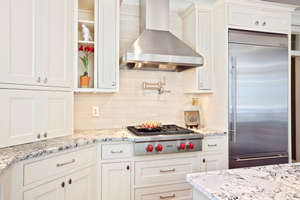 It is not enough to choose the right hood for the kitchen, it is also necessary to be able to operate it correctly. If anything burned in the kitchen, and it was filled with fire, then the dominant number of housewives close the door, include the hood, as a rule, at full capacity. At first, her work is more than effective, but, due to the lack of fresh air, the spoiled is thinning out. The device stops "pulling". The correct action is not to close the doors, but in the additional opening of the window in the room that is adjacent to the kitchen. Not in the kitchen.
It is not enough to choose the right hood for the kitchen, it is also necessary to be able to operate it correctly. If anything burned in the kitchen, and it was filled with fire, then the dominant number of housewives close the door, include the hood, as a rule, at full capacity. At first, her work is more than effective, but, due to the lack of fresh air, the spoiled is thinning out. The device stops "pulling". The correct action is not to close the doors, but in the additional opening of the window in the room that is adjacent to the kitchen. Not in the kitchen.
If a window or window is opened in the kitchen, the device will work on suction and filtration, followed by the release of air masses coming from the street, but the kitchen chand will remain suspended in the air, creeping through the rooms.
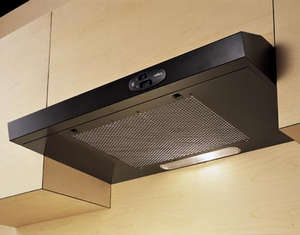 If you were able to choose the right hood for power, size and noise, then for its effective operation you need to turn on the appliance before the cooking surface of the cooker is turned on, and then turn off after fifteen minutes from the time cooking stopped. Many products are equipped with a residual running mode of the built-in fan or a special timer that automatically turns off the device at the right time.
If you were able to choose the right hood for power, size and noise, then for its effective operation you need to turn on the appliance before the cooking surface of the cooker is turned on, and then turn off after fifteen minutes from the time cooking stopped. Many products are equipped with a residual running mode of the built-in fan or a special timer that automatically turns off the device at the right time.
Wall fireplace hoods have one flat side for attaching to the wall. Wall-hung hoods of inclined type can save space in the kitchen. Corner models Are intended for installation on a joint of walls. For a spacious kitchen with hob, located in the center of the room, a good option may be hood.
Built-in hoods can be hidden in the kitchen cupboard or under the counter top. Hoods in the design "Domino" Mounted in the countertop and located at the level of the hob. The components of "Domino" look like narrow modules that can be combined on one table and combine them into a system.
Performance
The performance of the hood shows how much air can flow through the appliance within one hour in the air-exhaust mode. According to sanitary norms, air in the kitchen should change 10 to 12 times within an hour. Accordingly, to determine the necessary throughput, you need to calculate the volume of the kitchen and multiply it by 12, and for the exhaust hoods, multiply the result by 1.3 - the correction factor for the length of the duct, the depth of the ventilation shaft and the number of floors in the house. For example,













